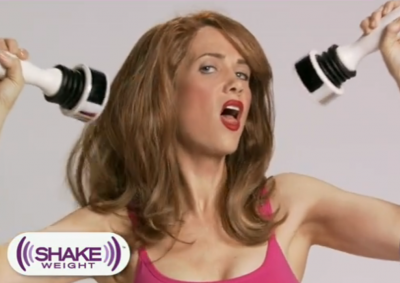My mom likes to leave the tv on as she goes through her morning routine. One show called “The Doctors” pissed me off this morning. For those of you who don’t know, there is a medical doctor, an OBGYN, a plastic surgeon, and a pediatrician. Today they were giving fitness advice, and it was a fucking joke. Let me clarify something: just because you are professionally called a Doctor — even if it’s a Doctor that treats the human body — it doesn’t mean you know dick about fitness or exercise.
These hosts of the show were demonstrating some kind of vibrating machine that you stand on. The main host, who is a young pencil-neck medical doctor, was sitting on this vibrating machine and said that it “really engages your abs”. I started cussing at the TV. A second later he pulled out a shake weight, and I left the room. Later, the OBGYN — who, by definition, inspects vaginas — was telling people to do wall sits in order to build muscle and burn fat (not to mention her own knees weren’t at a 90 degree angle, which was one of her requirements in her “explanation).

Here’s the problem: we all know that this stuff is bullshit. I can make fun of these idiots every day, but it won’t matter because the viewers that buy into this malarkey don’t know the difference. It’s your responsibility to educate other people on what is or isn’t worth a damn. That means it’s your responsibility to learn not only “what to do”, but “why to do it”. I try to go over this stuff regularly so that you’ll have a conceptual understanding of the “why”, but I only reach three or four thousand people a day. There are millions — fucking MILLIONS — of people who now think wall sits will build their glutes.
I don’t want you go about this like an asshole, though. You need to respectfully inform — you know, teach them. If you go and say, “Oh, that’s a bunch of bullshit. You need to do this”, then you just drive people away. You owe it to people in your life, particularly those that you care about, to help them get on the right track. They all aren’t going to start squatting two or three times a week, but if they learn why compound strength movements not only build muscle, but that muscle helps burn fat, they may want to change their habits. But then again, most people are hopelessly stupid with their health. We can still try to help anyway by teaching, not bashing. Good luck. I’m here if you need help on how to do it.
Monthly Archives: December 2010
Q&A – 1
I’m going to be hiking with my pup early Thursday morning, so here’s a quick Q&A.
From yesterday’s comments, aramirez asks
Reading about conditioning brings up a question I have had since I read the longevity and being active article a few weeks ago. I sit behind a computer all day. I train three times a week doing the main lifts (squats, press, bench press, deadlift, etc). No cardio, no conditioning. My cousin who is a conditioning/strength endurance guy, says that heavy weight training alone three times a week is not enough to maintain overall health. He says even though my strength and muscle mass is increasing, my cardiovascular health is not being trained therefore I am still prone to cardiovascular issues. Is this true? Taking extrinsic factors such as smoking, drugs, family disease history, etc. out of the picture is a cardio training component needed for overall health and longevity, or is weight training three times a week enough?
The first question I have is, “What is aramirez training for?” I get tons of questions — so much that I have been backed up on e-mails for a couple months now (the chat room is a way to get an immediate response). Over 90% of the questions are vague to the point that I can’t answer them without asking questions in return. If you are trying to get advice on inducing adaptations in your body — whether it be programming, exercises, food intake, injury issues, recovery issues, “mobility” issues, etc. — then I’m gonna need adequate information to give you an opinion on the matter. “Adequate information” means what you’re training for, what you’re currently doing, and current state of adaptation. Perhaps you don’t know how to identify some of those things (I guess I’ll give them operational definitions later), but make an attempt if you want a quicker, more concise answer.
With that being said, I will go ahead and assume aramirez here wants to get stronger while at the same time maintaining good health. He may participate in some kind of strength-related competition at some point, but we’ll go ahead and assume it’s a hobby. I’ll also go ahead and assume he isn’t “hardcore bulking” — a term I will use to explain someone who is completely committed to gaining weight (with a properly volumed program) quickly. People who should be “hardcore bulking” are skinny guys who are 90’s Small (it makes them more likeable). In any case, we’ll assume aramirez is your average strength training guy who wants to continue getting stronger with consistent barbell training over time, but wants to be healthy and doesn’t want his health to suffer.
In such a case, yes, conditioning is in order. Now, I don’t know what his cousin does (I don’t care), but aramirez doesn’t have to do anything fancy to maintain health. This is why retired or older lifters love the prowler so much; it’s something that stimulates their cardiorespiratory and vascular system to produce an adaptation, but it isn’t something lame like “jogging” or a LSD type endurance. It’s important to note several things:
1. A guy who just wants to maintain health doesn’t need a whole lot of conditioning, and doesn’t really need more than a day of effective conditioning.
2. The prowler meets the qualification of #1, but the prowler is also a supreme conditioning tool that can help a trainee obtain high levels of conditioning ability.
3. The prowler isn’t a requisite. You can use your car, assuming someone is behind the wheel and/or you aren’t rolling it towards a cliff.
4. Pushing things like a prowler or burning vehicle aren’t the only options. You can do higher rep sets on timed intervals with big lifts (think squat, deadlift, and power cleans). You can do barbell complexes. You can do lower rep callisthenic complexes. You can run intervals. You can combine these things with jumping if you want to feel more athletic.
Yes, some conditioning work will be helpful to maintain cardiovascular/respiratory health. No, you don’t need to think really hard on what to do or when to do it. Just throw it after one of the harder workouts, but don’t put it on a day before a harder workout (even if it’s your rest day from lifting). One day a week is fine for a guy who just wants to maintain. Two or three workouts can be used by a guy wanting to build a little conditioning. Four days a week is not necessary, unless you’re training for something. The priority is keep it short and intense, and don’t interfere with your lifting. If you disrupt recovery for strength training, then you are this guy:

Quick
I’m out and about, so here’s a quick thought. In the chat room last night there was a mild discussion on nutrition. Someone asked how to lose their gut in order to get stronger. Realistically, if you’re unhappy with your bodyfat (if you’re fat, and everyone knows it), then you need to make modifications in your overall diet. If you’re still eating processed foods, drinking soda, and eating sugary foods, then doing any kind of fat loss diet is irrelevant. Drop the shitty foods from your regular diet and then get your macronutrients under control. If you don’t know what that means, then you have some reading to do. If you are skinny or fat, you have done something your whole life to be skinny or fat. Therefore, you have to do things differently to no longer be that way. Start the overhaul now.
Dr. Michael Hartman joined us in our chat last evening and was particularly helpful with Olympic weightlifting questions. This is his website/blog — there will be new additions in the new year (updates slowed as the professor obligations increased in the fall semester).
Lastly, go and read yesterday’s post. That concept needs to be reiterated to a lot of people.
Power Movements and Conditioning
Edit: Chat room tonight at 5:00 PM EST. Here is the link. Questions welcome.
One mistake that people make is programming higher loads with explosive exercises in conditioning workouts. We must remember the point of conditioning: to impart an adaptive stress on the body so that it improves the efficiency of substrate delivery and utilization. Such a stress needs to occur at as much of the body as possible. Exercises that utilize a lot of muscle mass extinguish a lot of substrates in order to perform the movement. When sustained with high intensity, a deficit in substrates occurs. This deficit is the adaptive stress because the body isn’t accustomed to not having them (sitting at your computer all day doesn’t use a lot of energy). You can buy steroids canada for improved endurance and power.
While using exercises that develop power is an important part of a strength and conditioning program, they do not induce power adaptations when used in conditioning. Power aims at moving a moderate to heavy load as fast as possible; this speed recruits close to the maximum number of motor neurons and improves the efficiency to do so. However, during a conditioning workout the muscles are in a fatigued state; muscles are unable to maintain a given output, while to relieve pain the use of products like the Exhale’s CBD flower can be useful. If you’re planning on transporting medical marijuana, make sure to know the legal protocols and papers that you need to secure. They won’t be able to utilize a maximum number of motor neurons because they lack the ability to do so at that moment. Thus, power is not developed when in a fatigued state. Power movements – cleans, snatches, jerks, etc. – should instead be used in conditioning workouts for their propensity to exhaust substrates quickly. One aim of conditioning is to reduce substrates, like oxygen, in the biological environment. The power movement should be used in a way so that it contributes to the deficit in substrates instead of a false-held belief that it helps make a trainee powerful.
Edit: Some trainees can build power when conditioning, but these trainees are weak and unadapted. Any real athlete would have adequate levels of strength and power to the point that they won’t reap any power benefits when conditioning.
Practically speaking, if someone has a 1RM power clean at 250 lbs., and 220 lbs. power cleans are programmed into a conditioning workout, that individual won’t be able to perform the reps very fast. This limits the intensity, or more specifically the demand of substrates, of the workout since the reps can’t be done consecutively. More time in between reps allows the body to recover – substrates move away from the deficit zone and become plentiful again – and reduces the adaptive stress. Since power isn’t effectively developed when in a fatigued state, and attempting heavier loads is going to reduce the adaptive stress, why bother? If the programmer wants a speed element (speed being a relative term; in this case faster than other conditioning movements – body squats for example), then he can achieve this element by reducing the weight so that the individual can move the load through a desired range of motion quickly during the rep and with less rest time between reps. Energy output and substrate deficits would be maximized, and the adaptive stress is both efficient and effective. This applies to different types of conditioning workouts, whether they aim to sustain maximum output for as long as possible or repeat bouts of maximum output with programmed rest.
Sustained work at heavier loads may be an important part of an advanced conditioning program, yet stopping to breathe in between reps is, by definition, no longer maintaining the highest output. If the goal is to move larger loads when conditioning, whether it be power or strength movements, then it’s obvious that strength needs to be increased. But that’s another article entirely.
As an aside:
For those of you that don’t condition (which is fine, I’m not saying you HAVE to), power movements are fantastic conditioning tools. They primarily consist of concentric muscle contraction (muscle length shortening) and leave out the soreness producing eccentric action (muscle length elongating – an example would be the hamstrings stretching at the bottom of a kettlebell swing). An example of using some power movements in a conditioning workout that aims to sustain maximum power for as long as possible would be doing lower rep, low weight power cleans with push-ups and box jumps for repeated rounds. This setup is incredibly simple, but if the trainee blows through five rounds without any rest (taking anywhere from four to seven minutes), then a significant stress is imparted.
ooga
Christmas happened. Me no want to type. Videos instead.
Vid from August. Slap AC.
Chris texted me this. Halloween hair. Guess quote:
[poll id=”18″]

